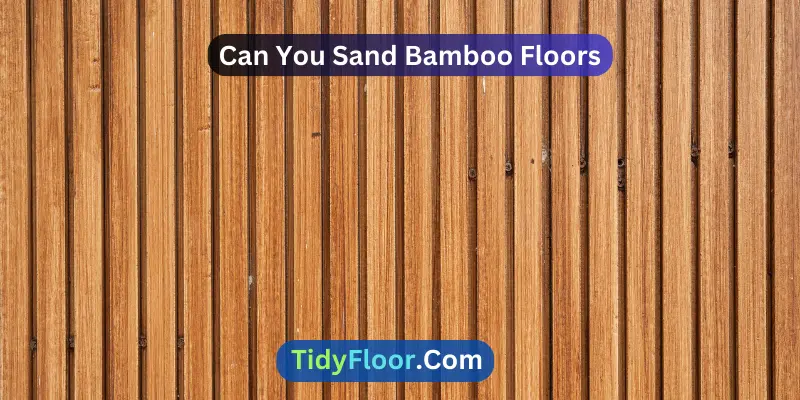Bamboo flooring has gained popularity in recent years due to its eco-friendly and durable nature. However, bamboo floors can show signs of wear and tear over time. While sanding is a common solution for other floorings, many may ask: Can you sand bamboo floors? The answer is yes! Sanding bamboo floors can be a practical and effective way to rejuvenate their appearance and smooth out imperfections.
Sanding bamboo floors involves preparing the area, using a floor sander with different grits, addressing edges, applying finish, and protecting with polyurethane. Careful execution yields beautifully rejuvenated and protected floors.
In this guide, we’ll walk you through the steps of how to sand bamboo floors, ensuring a successful and satisfying home improvement project. Keep reading to discover the right way of bamboo floor sanding.
Before moving on to the steps, have a look at the materials you need for bamboo flooring sanding.
- Sandpaper: Use a range of grits, starting with a coarse grit (around 36-60) and gradually progressing to finer grits (80-120) for a smooth finish.
- Tack Cloth: A tack cloth helps remove residual dust and prepares the floor for finishing.
- Floor Sander: A drum or orbital floor sander is required to sand the bamboo surface evenly.
- Safety Gear: Wear a dust mask, safety goggles, and ear protection to shield yourself from dust and noise.
- Vacuum and Broom: Keep a vacuum cleaner and broom handy to clean up dust and debris during and after sanding.
- Finishing Materials: You’ll need finishing materials such as stain, sealer, and polyurethane to protect and enhance the appearance of your sanded bamboo floor.
Time: A Day or Two
Cost: Dollars 120 To 240
How To Sand And Refinish Bamboo Flooring: 5 Step-By-Step Process
Bamboo floor sanding won’t damage or weaken bamboo floors if you do it in the right procedure. In this guide, I have explained the best way to sand bamboo floors which I have realized from my years of experience.
Step 1: Prepare the Area
Before diving into the sanding process, it’s crucial to prepare the area properly. Start by removing all furniture and accessories from the room to provide a clear workspace. Additionally, cover any vents, doorways, or openings with plastic sheeting to prevent dust from spreading to other parts of your home.
Step 2: Sanding Process
Here’s a breakdown of the sanding process:
a. Begin with Coarse Grit: Attach the coarsest grit sandpaper to your floor sander and start sanding along the grain of the bamboo floor. Work in small sections, overlapping each pass to ensure even sanding. Continue until the old finish is removed, and the bamboo surface appears even and smooth.
b. Progress to Finer Grits: Switch to finer grit sandpaper and repeat the sanding process, gradually refining the surface. This step will remove any remaining imperfections and create a smoother texture.
c. Edges and Corners: Use a hand sander or sandpaper to reach areas that the floor sander can’t access, such as edges and corners.
Step 3: Clean and Inspect
Once you’ve completed the sanding process, thoroughly clean the area. Use a vacuum cleaner and tack cloth to remove all dust and debris from the floor surface. Inspect the floor closely to ensure that it’s smooth and free of any noticeable imperfections.
Step 4: Apply Finish
After sanding, your bamboo floor is ready for finishing. Apply a high-quality bamboo floor finish, such as stain or sealer, according to the manufacturer’s instructions. Allow the finish to dry completely before proceeding.
Step 5: Apply Polyurethane
To provide added protection and a glossy finish, apply a coat of polyurethane to your sanded and finished bamboo floor. Use a clean roller or brush, and apply the polyurethane evenly across the surface. Allow it to dry according to the manufacturer’s recommendations before using the room again.
9 Tips About Sanding and Refinishing Bamboo Flooring: For Best Result
Sanding and refinishing bamboo flooring can be a rewarding way to breathe new life into your living spaces. Bamboo, known for its durability and sustainable qualities, can benefit from sanding to remove surface wear, scratches, and imperfections. Here are some essential tips to guide you through the process and ensure a successful outcome:
1. Assess the Condition:
Before starting, assess your bamboo floors’ condition. Light wear and minor scratches can often be improved with sanding. If the damage is extensive or the floors have been sanded multiple times, professional help might be necessary.
2. Plan and Prepare:
Empty the room and cover openings to prevent dust from spreading. Take your time to read equipment manuals and understand the sanding process before you begin.
3. Choose the Right Grits:
Start with a coarse grit sandpaper to remove the old finish and deeper scratches. Progress to finer grits gradually to achieve a smooth and even surface.
4. Work in Sections:
Divide the room into manageable sections and sand one area at a time. Overlapping passes with the sander ensures consistent results.
5. Address Edges and Corners:
For areas the sander can’t reach, use a hand sander or sandpaper to maintain a uniform appearance along the edges and corners.
6. Thoroughly Clean:
After sanding, use a vacuum and tack cloth to eliminate dust and debris. A clean surface ensures a flawless finish.
7. Seal and Protect:
Apply a clear polyurethane finish to protect your newly sanded bamboo floors. Choose the level of sheen that complements your style.
8. Allow Ample Drying Time:
Let the finish dry according to the manufacturer’s recommendations before stepping on the floors or returning furniture to the room.
9. Maintenance Matters:
Regularly clean and maintain your refinished bamboo floors to ensure their longevity. Use furniture pads, rugs, and proper cleaning products to preserve their beauty.
10 Mistakes to Avoid When Sanding and Restaining Bamboo Floors:
Sanding and restaining bamboo floors can transform the look of your living space, but it’s important to approach the process with care and precision to achieve the best results. To ensure a successful outcome and prevent common pitfalls, here are crucial mistakes to steer clear of:
1. Skipping Proper Assessment:
Failing to assess your bamboo floors’ condition before sanding can lead to unexpected issues. Deep scratches or extensive wear might require more than just surface sanding. Thoroughly examine the floors to determine the level of restoration needed.
2. Using Incorrect Grits:
Choosing the wrong sandpaper grit can be detrimental. Starting with grit that’s too fine might not effectively remove the old finish while starting too coarse can damage the bamboo surface. Follow a proper progression of grits to achieve a smooth result.
3. Neglecting Safety Gear:
Sanding generates dust and noise, making safety gear essential. Not wearing a dust mask, goggles, or ear protection can lead to health hazards and discomfort.
4. Rushing the Sanding Process:
Rushing through the sanding process can result in uneven surfaces and missed imperfections. Take your time and work in small sections, ensuring each area is sanded thoroughly before moving on.
5. Inadequate Cleaning:
Skipping proper cleaning after sanding can lead to dust particles getting trapped under the finish, compromising the final result. Use a vacuum and tack cloth to remove all dust before applying any finishes.
6. Not Testing Stain Colors:
If you’re restaining your bamboo floors, not testing the stain color on a small area can lead to unexpected color variations. Test the stain on an inconspicuous spot to ensure it matches your desired hue.
7. Rushing the Drying Process:
Applying finish before the floors are fully dry can result in a tacky, uneven finish. Allow ample drying time as specified by the product instructions.
8. Poor Application of Finishes:
Applying too much or too little stain or polyurethane can result in streaks, uneven color, and an inconsistent finish. Follow manufacturer guidelines for application techniques.
9. Not Protecting Newly Finished Floors:
After the refinishing process, not using furniture pads, rugs, or proper cleaning products can lead to premature wear and damage to your newly refinished floors.
10. Skimping on Maintenance:
Neglecting regular maintenance after sanding and restaining can diminish the longevity of your revitalized bamboo floors. Proper cleaning and care will help preserve their beauty over time.
FAQs:
Can I Sand Bamboo Floors Myself?
Yes, you can. Sanding bamboo floors is a DIY-friendly project if you have the necessary tools and follow proper instructions.
Is Sanding Bamboo Floors A Noisy Process?
Yes, sanding generates noise. Wearing ear protection is essential to safeguard your hearing during the process.
Do I Need To Sand The Entire Bamboo Floor?
Sanding the entire floor is recommended for uniformity. However, you can spot minor imperfections if needed.
How Long Does The Bamboo Sanding Process Take?
Depending on the area’s size and your skill level, sanding, cleaning, and finishing can take one to two days.
Can I Use A Regular Sander For Bamboo Floors?
Using a floor-specific sander is advisable for best results, as they’re designed to handle hardwood surfaces effectively.
Should I Apply Stain After Bamboo Sanding?
Applying stain is optional but can enhance the bamboo’s color and hide minor imperfections for a more uniform appearance.
How Soon Can I Walk On The Floors After Finishing?
Allow the finish to dry for at least 24-48 hours before walking on the floors, and avoid placing heavy furniture for a few days.
Can I Change The Sheen Of The Bamboo Finish?
Yes, you can choose from various levels of sheen (e.g., satin, semi-gloss, gloss) based on your preferences and desired aesthetic.
Can Sanding Bamboo Floors Fix Deep Scratches?
Sanding can address minor scratches and imperfections, but deep ones might require more extensive repairs or professional assistance.
Are There Any Health Risks From Sanding Bamboo Floors?
Sanding generates dust, which can be harmful when inhaled. Wearing a dust mask and safety goggles is crucial to protect your health during the process.
Conclusion
It is indeed a viable option to sand bamboo floors to restore their beauty and maintain their longevity. By following the step-by-step process outlined in this guide, you can achieve professional-quality results and enjoy a renewed floor surface that enhances the aesthetic appeal of your home.
With proper care and maintenance, your sanded bamboo floors can continue to impress for years to come.


